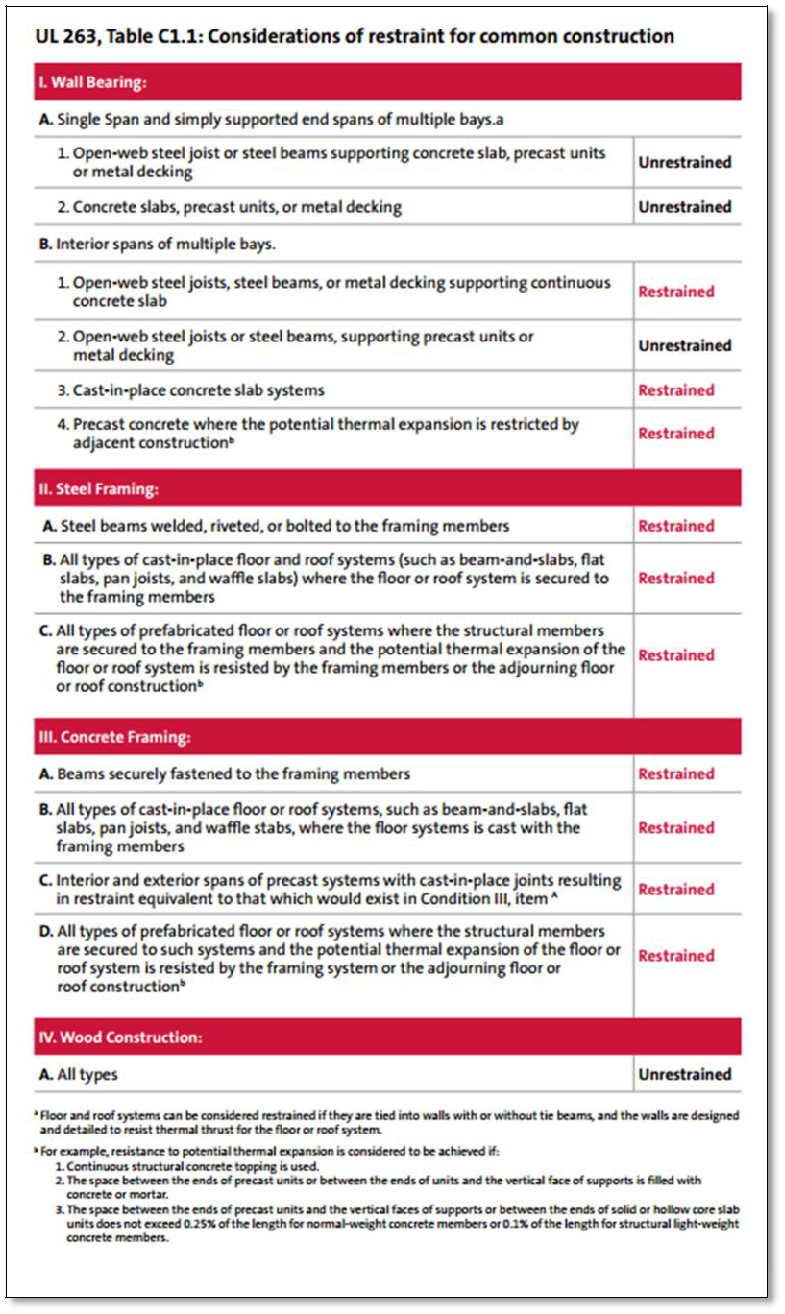Restrained and Unrestrained Assemblies – What Designers and AHJs Need to Know
Section 703.2.3 of the International Building Code (IBC) specifies that fire-resistance-rated assemblies tested in accordance with ASTM E119 or UL 263 are not to be considered to be restrained unless evidence satisfactory to the building official is furnished by the registered design professional showing that the construction qualifies for a restrained classification in accordance with ASTM E119 or UL 263. It also specifies that restrained construction shall be identified on the construction documents.<strong
Knowing that a rated assembly qualifies as restrained construction in some cases reduces the amount of protection required to achieve a given rating. This article describes two sources of information that can be used to demonstrate if an assembly can be considered restrained.
The two tests standards used to determine fire-resistance ratings, ASTM E119 and UL 263, the Standard for Fire Tests of Building Construction and Materials, both define restraint in buildings. UL 263 states “Floor-ceiling and roof-ceiling assemblies and individual beams in buildings should be considered restrained when the surrounding or supporting structure is capable of resisting substantial thermal expansion throughout the range of anticipated elevated temperatures. Constructions not complying with this definition are assumed to be free to rotate and expand and should be therefore considered as unrestrained.”
Both test standards contain Conditions of Acceptance for determining restrained and unrestrained ratings of horizontal assemblies based on the data generated during fire testing. The resulting published certifications provide both restrained and unrestrained ratings, along with descriptions of the protection needed to achieve each rating. The decision on which of the published rating to use is dependent on whether the construction in question is restrained or unrestrained based on the above definition of restraint. The requirements for unrestrained ratings are more conservative, often requiring more fire protection. And since they are more conservative, they can always be used in conditions where the assembly is judged to be restrained.
Determining restrained conditions
One source of information that can be used to help determine if a rated assembly is being installed in a restrained application (as referenced in IBC Section 703.2.3) is included in Appendix C of UL 263. The other is information included in the UL Guide Information for Fire Resistance Ratings – UL 263 (BXUV). Once the restrained versus unrestrained determination has been made and approved by the building official, the designer and involved contractors follow the published certification to determine the required fire protection to achieve the required rating.
Table C1.1 of UL 263
Appendix C1.1 of UL 263 provides general information with respect to the use of the restrained and unrestrained ratings published in the various certifications of horizontal assemblies.
The definition of restraint in buildings specified in Table C1.1 requires the exercise of engineering judgment to determine what constitutes restraint to “substantial thermal expansion.” Restraint may be provided by the lateral stiffness of supports for floor and roof assemblies and intermediate beams forming part of the assembly. In order to develop restraint, connections must adequately transfer thermal thrusts to such supports. The rigidity of adjoining panels or structures should be considered in assessing the capability of a structure to resist thermal expansion. Continuity, such as that occurring in beams acting continuously over more than two supports, will induce rotational restraint which will usually add to the fire resistance of structural members. Table C1.1 of UL 263 (shown below) addresses common types of constructions and specifies whether that construction is considered as restrained or unrestrained. Having these examples in mind, the user should be able to rationalize the less common types of construction.
The foregoing methods of determining the presence or absence of restraint, according to the type and detail of construction, represent only one procedure for establishing fire-resistance ratings. This procedure alone does not represent all restrained and unrestrained construction conditions
UL Guide Information for Fire Resistance Ratings – UL 263 (BXUV)

Since the information shown in Table C1.1 of UL 263 may not be appropriate for all conditions of restraint in actual structures, the UL Guide Information for Fire Resistance Ratings – UL 263 provides additional guidance. It also recognizes the exercise of engineering judgment is required to determine what constitutes “substantial thermal expansion” when determining the conditions under which the restrained or unrestrained ratings should be used.
Restrained conditions for the fire-test assemblies are provided by constructing floor-, roof- and beam test assemblies within nominal 14 ft by 17 ft frames of composite steel/concrete cross sections having an approximate stiffness (EI/L) of 850,000 kip-in. and 700,000 kip-in. along the 14 ft and 17 ft sides, respectively. The frame stiffness remains constant throughout the fire test because the test frame is insulated from the fire environment.
When applying the published restrained ratings, it is recognized that the individual responsible for the design of the fire-resistance-rated construction may ascertain that a different degree of restraint may be provided to the building assembly during a fire condition than was provided to the test sample during the fire test. Under these conditions, the designer may review the Conditions of Acceptance for restrained and unrestrained assemblies and beams in UL 263 for additional guidance in determining whether restrained or unrestrained ratings should be specified.
Summary
As can be seen the information included in UL 263, Appendix C reproduced above, and in the UL Guide Information for Fire Resistance Ratings – UL 263, can be utilized by the design professional to demonstrate that a given construction qualifies for a restrained classification in accordance with UL 263.
Copyright material from Issue 1, 2015, The Code Authority newsletter. This material may not reflect changes that have occurred since its original publication.